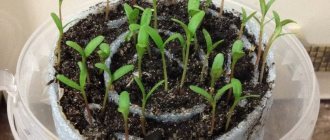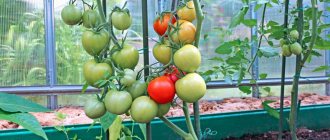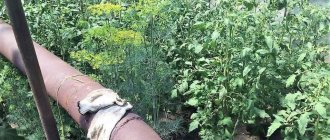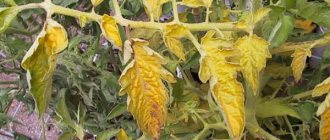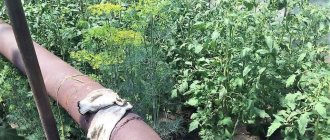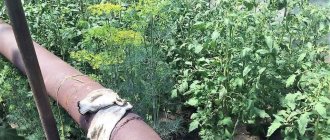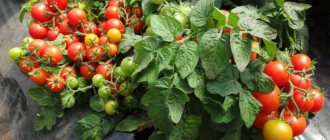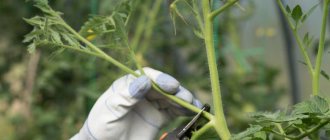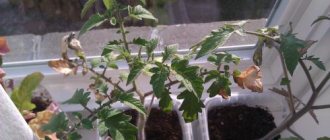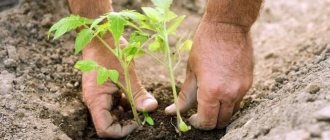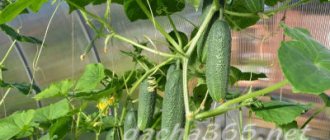When growing tomatoes, picking seedlings is a very important and responsible moment.
Carrying out this procedure will allow the tomatoes to develop faster, and you will avoid many problems with the seedlings. Why else is this procedure needed? Is it necessary to do it? What could happen without her? Let's find out in our article today.
When to pick tomatoes after germination, at what stage of growth, in which leaf phase: timing
If you are planning to pick tomatoes for the first time, then you should do it when the seedlings already have the first 2 well-developed leaves. As a rule, they appear 10 days after the seeds germinate. Professional gardeners advise using the lunar calendar, which will tell you when to do picking and other garden work.
Picking tomatoes
There are certain conditions during which you should definitely start picking tomatoes:
- If you want the seedlings to have strong roots, do the picking earlier. Then, after it is carried out, a wide network of lateral root system is formed.
- If you planted tomato seeds in one box, then transplant the seedlings into separate cups. After this, the plants will develop healthy and adapt better when transplanted into the ground. If you leave the seedlings without replanting, then they will be weak and the root system will become intertwined. In the future, it will be difficult for you to plant it, and even damage to the roots is possible.
- If the seedlings grow densely and form unevenly, sort them in the early stages of development, leaving viable tomatoes.
- Picking is needed if the soil you use contains pathogens. Picking will become like a “surgical operation”, thanks to which you will remove the infected seedlings and transplant healthy ones into new soil. Thanks to this event, you will be able to save some of the plants and stop diseases in the initial stages.
- If your seedlings look good, but it is too early to plant them in open ground, then picking will stop the development of the seedlings. Please note that overgrown tomato plants do not tolerate transplantation well.
What size glasses should you use to pick tomatoes?
An important condition for seedlings to feel comfortable is a spacious container. For tomatoes, take cups with a diameter of at least 10 cm. Thanks to them, you will create ideal conditions for the plants to develop; the roots will not suffer, but will begin to develop more actively.
Which cups to choose? You can take paper or cardboard. Such cups are good because they do not require re-planting into the ground, since they will rot in the ground over time, therefore, you can replant the seedlings with them.
Peat containers are also considered ideal. You can put tomatoes into plastic containers. Before transplanting, simply cut the cups, free the seedlings and plant them in a place prepared in advance. Instead of cups, use ordinary plastic bottles. Trim them by about 15 cm to make a volume of 200 ml.
Glasses for pickled tomatoes
Experts recommend adhering to the following rules:
- Do not deepen the seedlings beyond the growing point, otherwise they will grow slowly.
- Before planting in cups, disinfect the roots using potassium permanganate. Small seedlings are considered quite weak, therefore, they will not cope with bacteria. Don't miss this manipulation.
After 2 weeks, replant the seedlings. Take a larger container, with a volume of at least 500 ml.
Caring for tomato seedlings
The sprouted tomatoes are urgently transferred to a sunny window. In the dark, seedlings can grow tall in one day. Ideally, young plants are illuminated with special lamps during the first two weeks. The seedlings are kept at a temperature of about +18o C. Water moderately when the soil dries out. It is better to do this using a syringe or syringe without a needle, being careful not to splash on the stems.
It is convenient to water the seedlings with a syringe because the soil is not washed away
What kind of soil is needed for picking tomatoes, at what temperature?
Before picking tomatoes, prepare the soil in advance. Prepare the soil for replanting 7-10 days in advance. Make sure the soil is at room temperature.
- If you prefer ready-made soil that you purchased in the store, then do not add anything to it. As a rule, the finished soil is perfectly balanced and contains all the nutritional components.
Correct temperature
- Prepare the garden soil in advance. First, warm it up to room temperature for about 10 days. Add compost to the soil in the following proportion: 2:1. Mix the soil well. Leave for 2 days.
Take soil for transplanting seedlings that is fertile and has neutral acidity. Increased acidity of the soil causes the development of seedlings to stop after picking. To avoid this, add some ash to the soil.
Do I need to pinch the roots when picking tomatoes?
The roots of tomatoes are pinched during picking to obtain more powerful roots. This practice has become firmly established in the life of every gardener. If you decide to pinch the central root of a tomato, keep in mind that once it is cut, it will stimulate the growth of the superficial root system. In this case, you will have to water the tomatoes more often and add additional fertilizer.
When picking tomatoes, you need to pinch the root as well.
During picking, pinch the central root by about 1/3 of the part. After this, the growth of the plants will slow down a little, and therefore they will stop stretching and outgrowing.
The most favorable days according to the Moon: table
Success depends not only on compliance with the rules of the procedure, but also on the correct choice of timing for picking tomatoes. If you transplant too early, the fragile, weak roots will not take root well and get used to new conditions; if you waste time, the overgrown roots will intertwine and it will be impossible to separate them without damage.
Transplantation begins when the seedling has two true leaves. About 20 days pass from the moment of emergence to the moment of picking. How quickly real leaves form depends on the variety and growing conditions.
Many people believe that it is best to pinch the roots when they react weakly to damage, namely to the waxing moon - during this period, liquids rush upward, to the above-ground part.
How to properly plant tomatoes for seedlings in a diaper: step-by-step instructions
Picking tomatoes planted using this method is very easy, so you can handle the job without any problems. In addition, seedlings after such picking will never get sick. The procedure is performed as follows:
- Prepare all the necessary tools, including film (you can replace it with other similar material).
- Cut out rectangles from the film. They should look like a piece of notebook paper.
- Place soil (1 tbsp) in the left corner at the top of the diaper.
- Place the plant on top of the soil. The leaves should be above the diaper.
- Add soil again (1 tbsp). Take the soil slightly moist.
- To prevent the film from unfolding, secure it using an elastic band.
How to properly plant tomatoes for seedlings in cellophane: step-by-step instructions
Tomato seedlings can also be transplanted into regular cellophane. You can use the previous method, but you should take into account the characteristics of the roots. If you damage the root system during picking, their restoration will be carried out very quickly. The roots will form powerful and branched. Therefore, you can replant the seedlings several more times in the future. You will not harm the plants.
Tomatoes in cellophane
When picking, do not pick up weak stems with your hands. Take the plants by the first couple of leaves. Many gardeners and gardeners pinch out the central root. Do not use this method if you are going to plant tomatoes in a dry place where you plan to water infrequently. The central root absorbs water more actively than the lateral roots.
For transplanted plants in a bag, when a full 7 leaves appear, unwind the rolls, add a couple of spoons of fertilized soil to the root system, and wrap again.
Is it necessary to do this?
Seedlings are planted in larger containers than those originally selected for seed germination. This is necessary to ensure more comfortable growth of each plant.
Expert opinion
Klimkina Elena Vladislavovna
Florist, businessman. Organized her business on a country plot of land
When several tomatoes grow in one box at the same time, the stronger plant suppresses the other, less powerful and strong one. The roots of tomato seedlings develop quickly and there should be enough space for them in the pot, otherwise the plant feels bad, withers, and in this case the harvest can be lost completely.
When to pick tomatoes planted in a snail?
Be sure to keep an eye on the period during which your tomatoes will grow and sprout in the snail. As soon as you notice the first sprouts, place the seedlings on the windowsill and remove the bag. This is necessary to ensure that your tomatoes grow evenly in the future.
Plant tomatoes in a snail around the end of winter if you want an early harvest. If you want to plant tomatoes for planting in open ground, then plant the plants in the second week of March. Sow seeds at different times.
Landing in a snail
Plant tomatoes sprouted in a snail after the same period of time as during normal planting. To ensure that your seedlings do not lack soil, compensate for this with regular fertilizing. Add fertilizer 2 times a week using humic acids.
Are growth stimulants needed?
There is no consensus on the use of growth stimulants. But the main purpose of picking is the development of the root system. This means that it is more important not to direct all the tomatoes’ forces into growth for now, but to give them the opportunity to form a correct and developed root.
To do this, it is recommended to use all types of complex fertilizers. It is better to give preference to those varieties that are rich in superphosphates, urea or sodium sulfate.
The very first feeding can be done no earlier than two weeks after picking. The next time is carried out after approximately the same period of time.
Is it possible to plant tomatoes directly into a greenhouse?
Dive the seedlings into the greenhouse if the soil has already warmed up well and the threat of frost has passed.
- The ground temperature at a depth of 20 cm should be +14°C. Choose plants that already have 6-7 true leaves and a strong root system. At this age, plants begin to quickly get used to the place and different temperatures.
- If you live in the southern regions, then plant the tomatoes in a well-prepared bed by mixing sand, peat, and soil. Make the height of the bed no more than 20 cm. Monitor the temperature. If it is cool, be sure to provide heating in the greenhouse.
- Use manure for such purposes. Place it around the perimeter of the trench, sprinkle with sand and regular soil. Due to the rotting that occurs, heat will be generated.
How to pick thin tomato seedlings if they are stretched out: tips
Are your tomato seedlings stretched out? There are many reasons for this phenomenon. But you can easily fix the situation.
The main reasons why seedlings stretch are:
- Lighting. All living organisms on earth try to reach for sunlight. If you don't provide enough light, your seedlings will continue to actively grow.
- Are your plants densely planted? That's why they block each other's light. Remember the main rule - fewer plants are better. Plant fewer tomatoes, but in the end you will get strong and strong bushes.
- Overprotectiveness. Excessive attention also affects plants, sometimes causing harm. Sometimes, due to frequent watering and fertilizing, plants begin to actively grow, and therefore stretch out. Water the tomatoes when the soil becomes dry.
- Incorrect temperature. Try lowering the temperature in the room where your tomatoes are growing. So that it has the proper appearance and the desired phase of development before picking.
Picking thin seedlings
Correct the problem as follows:
- Plant the plants in extended boxes. Make even grooves in the soil; the holes should not be very deep. Carefully separate the seedling from other seedlings and transplant into a container with soil. Do this with other plants. Plant the seedlings almost lying down, but the top of the plants should be vertical. Water the holes before picking, place the bushes in them, sprinkle the root system, while lifting the top of the seedlings. Leave the top of the plants with leaves at the top. Then press down the soil and water the tomatoes.
- Pinch off the tops and place in a container of water. Leave 6 leaves on each bush. After 1.5 weeks you will notice roots on the sprouts. When their length is 2 cm, plant the plants in the ground.
- If your seedlings have stretched out long before picking, add soil to the container. Using soil, increase the required “height” so that the plant stems are covered.
Preparing soil and seeds - what you need to know?
Tomatoes are the most popular vegetables in the nightshade family to grow at home. They are considered a heat-loving and finicky vegetable crop, therefore, in order to subsequently get a good harvest, you need to properly prepare the soil and process the seeds for seedlings.
Soil for tomatoes must be prepared in the fall and then kept under certain conditions during the winter. To get a good plant, the soil must be as enriched as possible. There are several optimal soil compositions that are usually used for seedlings, but, in our opinion, the best option for growing early, mid-season and late varieties is the following soil composition:
- garden or forest land - 50%
- high-quality humus - 20%
- river sand, wood ash and lime
All of the listed components must be thoroughly mixed, while sand, ash and crushed chalk can be mixed in various proportions. The prepared soil should be placed in spacious pots or other containers for growing vegetables at home. In the spring, a few days before planting, the seeds are prepared.
Seeds must undergo preventive treatment. To do this, you need to dissolve 15–20 grams of potassium permanganate in warm water and place the seeds there for several hours. Healthy and full seeds will gradually sink to the bottom; those that remain on the surface can be removed, since it will not be possible to obtain seedlings from them. Seeds can also be germinated, but this is no longer a mandatory procedure.
It is believed that after germination, the seeds become more stable and strong. Aloe juice is well suited for germination, as it is a well-proven biological stimulant. A zirconium solution can also be used. Seeds should be placed in the solution for 1–2 days. Then wrap them in a loose, damp cloth and wait a few days until the first shoots appear.
How to use "Kornevin" when picking tomatoes?
"Kornevin" is a well-known stimulant that allows roots to grow more actively. This drug is not a fertilizer. "Kornevin" is a hormonal drug that contains biologically active components. The main active component of Kornevin is indolylbutyric acid. When acid penetrates the soil, it becomes heteroauxin, stimulating seedlings to actively grow roots.
During picking, tomatoes experience stress, as a result of which the plants themselves begin to form hormones. The main thing you should remember at this stage is to carry out the picking itself correctly.
Stimulant when picking
Do not use “Kornevin” for feeding and more active development of tender seedlings. When picking, treat only adult plants or cuttings with the drug. “Kornevin” may have a detrimental effect on more delicate plants.
When picking, use:
- Dry matter. Mix “Kornevin” with ash (10:1). Treat the planting site and roots of the seedlings with the mixture.
- "Kornevin", diluted in water. Add the drug (1 g) to water (10 l). Water the seedlings with this mixture.
Water for watering seedlings
- The optimal water temperature for seedlings is 20-25°C, so before watering the plant, the water is heated if necessary or allowed to stand in a warm room until the water temperature reaches room temperature.
- It is not recommended to boil water for irrigation, as during this process the water loses oxygen, which has a bad effect on the seedlings.
- Filtered water is an excellent option for moistening seedlings, and if there is no filter, you can let the water sit for 1-2 days. Acidified water will be useful for seedlings: dissolve 1 peat tablet or 1 g of citric acid in 10 liters of water.
- The ideal water for watering seedlings is melt or rain, that is, as close as possible to the natural environment. But you can use such water only if you live far from industrial enterprises and big cities.
How to plant tomatoes so as not to dive?
- Do you want to grow tomatoes without picking? Then take separate containers for planting for each plant, filling 1/3 of them with soil.
- Make drainage holes in the cups, place them on the windowsill, and place pallets under the containers.
- Take loose, fertile soil for tomatoes. Prepare the soil yourself or buy it at the store. Before you sow the seeds, neutralize the soil from pests (calcine it in the oven).
- Plant the seeds in moist soil. You can soak them in advance, then they will begin to sprout more actively.
- Plant the seeds not very deep. The optimal depth is 1 cm.
- When you plant the seeds, moisten the soil a little.
- To make the seeds germinate faster, place the containers in a warm room. The ambient temperature should be +22°C.
Containers for the procedure
For picking, it is necessary to use exclusively individual containers - plastic cups, peat pots, plastic cassettes. The optimal volume is 0.5 liters.
If you replant in smaller containers (for example, 0.2 l), you will need a second pick.
Important! Plastic cups, pots, and cassettes must have drainage holes! If they are not there, then you must make them, for example, with a nail, an awl, or scissors. But peat pots don’t need holes; they already allow moisture to pass through perfectly.
Is it necessary to pick tomatoes? What happens if you don’t pick them?
Many gardeners speak poorly of picking. They claim that because of it, the seedlings experience severe stress. But that's not true. Through this process you:
- Provide your tomatoes with comfortable conditions for normal development
- Sorting out strong seedlings and discarding sick ones
But you decide whether to use picking or not, taking into account the method of growing seedlings. You can initially plant tomatoes in separate cups or peat tablets. Therefore, you will not have to replant them in the future.
